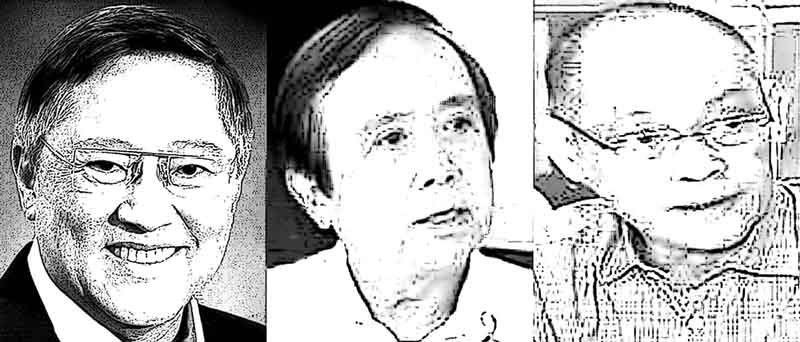The GMA (Gloria M. Arroyo) years averaged only 4 percent  p.a. GDP growth  .Net of a galloping population growth of 2 % p.a, it was a miniscule per capita growth. Poverty levels remained high.
President Benigno Aquino’s team did so much better- averaging 6 % p.a. average growth in 6 years. The pie was grown- plus the improved sovereign risk credit ratings- but where was the equitable distribution? The top 20 Filipino families upped their rankings in the world’s richest list. But at the end of Aquino’s term 3 of 10 Filipinos still languished below the poverty line index.
Poverty and inequality are now the two-headed monster that the Duterte economic team will have to wrestle with. Â Fortunately, Team Duterte Economics is a good one.
Finance secretary Sonny Dominguez has been immersed in private businesses (micro economics) and is balanced by Dr Ernesto Pernia’s (NEDA director general) macroeconomic savvy with his long term exposure as senior economist of the Asian Development Bank.
The two’s strengths are bundled together into a GAA ( national budget) which translates the goals into brass tacks economics by funneling scant resources to where they will yield the best socio-economic returns for a poor, grossly imbalanced structure between the haves and the have-nots. There we have an experienced budget manager in Benjamin Diokno .
The rate of 46 % RP inequality index is higher than the ASEAN’s 42 %. On the other hand, the poverty index is highest in RP at ( 26 %) compared to the ASEAN
neighbors: Thailand (11), Vietnam (8.4) and Malaysia a low (1).
Dr Pernia said the target is to reduce poverty by 1.0-1.5 % per year so that at the end  of the 6 years of president  Rodrigo Duterte, this shall be at about 16 % poverty index .
Is there regional inequality, as well? Their figures is that Metro Manilans account for 37% of the GDP and the progressive Calabarzon (including Metro Manila) is 75 % of GDP. One can almost sense where the highest incidence of poverty are therefore located.
The per capita of the average Metro Manilan is twice that of the national average and “13 times more than that of the ARMM folks”, the nation’s poorest region and the most politically volatile.
Team Duterte pointed out RP is both a consumption -driven and service-driven economy from the demand and supply equation points of view. Like many less developed countries, this consumption-driven orientation should aim for an Investment- driven growth and the service sector swing more  to manufacturing and agricultural-side bias in order to create more jobs and improve per capita income.
It goes without saying that the answers would include regionally-dispersed growth from redirected fiscal and economic policies and attract more Direct Foreign Investments. It is clear that the quadrupling of “per capita income ” in the last 5 years of the Aquino era was not  enough due to its starting from a very low base.
The 4 million new jobs created by the Aquino administration obviously fell short since 1 million new job entrants also seek for employment every  single year-straining unemployment levels.
There are basic issues to tackle to attract more investments. Peace and order (owned up by the president himself), liberalizing ownership of foreigners of certain industries, subsidizing the excessively high power costs in the country, reducing corporate tax from 32 % to a more ASEAN-competitive rate of 25 %, and the proposed splitting of the DENR into environment and natural resources.
Because one  must note that RP is among the top 5 minerally-blessed resources-full countries in the world and their development needs huge chunks of capital not usually found in a Third World like ours. Fiscal strength can be further enhanced with strong revenue collections engendered through reforms from such known citadels of corruption like the BIR and Bureau of Customs.
Team Duterte estimates the daily loss of revenues in BOC alone is a frightening  P300-M per day.
Inequality can be addressed by more progressive taxation, expanding the conditional cash transfer in terms of people covered and benefits included, regional dispersal of government spending in infrastructure and livelihood generation, redevelopment of the blue economy (which is 70% of the nation’s resources and geography) and massive injection of developmental funds to the slackening agricultural sector (rural areas).
At 25 % individual tax and 12 % VAT, the Filipino worker is overtaxed at an effective tax bite of 37%. Finally, there are the existing political dynasties ,monopolies. oligopolies and duopolies -that have for many years siphoned wealth and opportunities to only a narrow few to the prejudice of the many.These disruptive entities should be broken up .
The road to real inclusive growth is long and winding indeed. Â Those who fail to plan, plan to fail.Time to roll down the sleeves and wrestle down poverty and inequality.
For comments: email to dejarescobingo@yahoo.com or bohol-rd@mozcom.com

